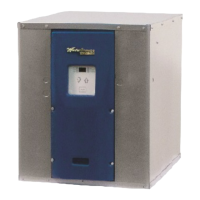
Do you have a question about the WaterFurnace Envision NSW018 series and is the answer not in the manual?
| Brand | WaterFurnace |
|---|---|
| Model | Envision NSW018 series |
| Category | Heat Pump |
| Language | English |
Connects the unit's water lines to the system, ensuring proper flow and insulation.
Specifies voltage, current, and wiring requirements for the unit's operation.
Outlines the sequence for safely powering up and commissioning the unit.
Details regular checks and servicing to ensure optimal performance and longevity.
Highlights hazards and precautions for personnel installing and servicing the equipment.
Advises on using secondary heat exchangers for specific water conditions to prevent corrosion.
Provides guidance on handling and storing units to prevent damage and maintain integrity.
Specifies suitable indoor environments and clearance needed for proper operation and service.
Details how to properly position and secure the unit on its base for stability.
Emphasizes system designer's responsibility for ensuring acceptable water quality per guidelines.
Advises on the use of treated water and avoiding untreated water to prevent equipment damage.
Recommends secondary heat exchangers for applications with water quality issues.
Details requirements for connecting water lines, insulation, and material compatibility.
Provides specific instructions for installing and operating units with open loop systems.
Illustrates system configuration for providing domestic hot water.
Explains how to connect the heat reclaiming hot water generator coil and required kits.
Covers component selection and installation criteria for hydronic piping systems.
Details selection and installation of valves for isolation and flow control.
Specifies requirements for installing check valves to prevent backflow.
Defines the requirement and sizing for buffer tanks in hydronic systems.
Recommends and details the installation of pressure relief valves for safety.
Highlights the importance of backflow prevention for system integrity.
Explains the function and installation of pressure reducing valves.
Describes the role of expansion tanks in managing system pressure fluctuations.
Advises on selecting elbows and tees to minimize pressure drop.
Specifies when antifreeze is necessary for system protection.
Recommends dielectric unions to prevent galvanic corrosion between dissimilar metals.
Describes field-installed pump kits for earth loop flow requirements.
Details the factory-installed heat reclaiming hot water generator coil.
Explains available kits for providing load-side liquid flow.
Covers the benefits and function of the IntelliStart soft starter.
Lists available kits for facilitating loop and load side water connections.
Provides dimensional data for geo storage tanks used with the system.
Explains the procedure to convert a unit from 230V to 208V operation.
Provides instructions for moving the unit's control box to a different location.
Illustrates the electrical connections for the load circulator pump.
Shows the wiring for a dedicated flow center.
Depicts the wiring configuration for multiple units sharing a flow center.
Details the specific wiring for heating-only residential units.
Illustrates wiring for reversible units equipped with IntelliStart.
Describes unit control using the internal controller based on water temperature.
Explains how to control the unit using an external aquastat.
Provides wiring guidance for connecting an aquastat to a reversible unit.
Details how to stage multiple units using primary/secondary control.
Explains staging units when using an external aquastat.
Step-by-step guide to reconfigure a heating-only unit for cooling operation.
Shows jumper settings on the control board for different operating modes.
Lists essential checks before applying power to the unit.
Step-by-step guide for starting the unit in primary mode.
Step-by-step guide for starting the unit in secondary mode.
Describes the timer preventing rapid compressor cycling after shutdown.
Explains signals from high/low pressure and freeze detection safety controls.
Defines the adjustable temperature ranges for heating and cooling modes.
Details the Pump Sampling (PS) and Continuous Pump (C) modes.
Explains the operation of the pump sampling control mode.
Describes the operation of the continuous pump control mode.
Outlines how to use test mode for faster troubleshooting.
Introduces retry and no-retry fault categories and their behavior.
Details how retry faults are handled before lockout.
Describes the conditions and display for a high-pressure fault.
Describes the conditions and display for a low-pressure fault.
Explains the freeze detection fault and its parameters.
Lists faults that prevent operation until resolved.
Describes the fault triggered by excessive load side water temperature.
Details faults related to open or shorted water temperature probes.
Explains faults related to open or shorted freeze detection probes.
Describes the fault triggered by low control voltage.
Provides instructions on how to reset unit lockouts.
Explains how settings are retained during power outages.
Describes the LEDs, buttons, and display on the unit's control panel.
Guides users on how to adjust the heating or cooling setpoint.
Details how the unit operates when controlled by an external aquastat.
Lists and explains various configurable parameters for the control board.
Defines abbreviations and terms used in the manual for calculations.
Provides important context and usage notes for performance data.
Presents performance data for units in English (IP) units.
Discusses managing high source temperatures during heating operation.
Details suction, discharge pressures, superheat, and subcooling for heating.
Details suction, discharge pressures, superheat, and subcooling for cooling.
Shows how to adjust performance based on antifreeze type and concentration.
Lists causes and corrective actions for compressor non-operation.
Addresses potential causes for reduced heating or cooling output.
Identifies sources of unusual noise and provides remedies.
Guides on interpreting control board error codes and settings.
A table mapping display codes to specific failures and diagnostics.
Provides overall recommendations for system upkeep and care.
Step-by-step instructions for cleaning the heat exchanger.
Illustrates the setup for cleaning the heat exchanger.